Getting started with Accounts Payable: Bill maker/checker
Bill makers/checkers have access to all bill/PR/PO Peakflo features in Accounts Payable. They can create, edit and read budgets, bills, PRs, POs, vendors, vendor credit notes, and reports.
This guide is divided into below sections (recommended to go through it in this flow):
- What are approval policies?
- How to configure the types of approval emails notifications?
- How to view budget?
- How to create Vendors?
- How to create PRs?
- How to create POs?
- How to manage bills?
- What are custom fields?
- How to manage my approvals?
- How to view credit notes?
- How to view receipt notes?
- How to view accounts payable reports?
- What is AP Dashboard?
- How to check accounting?
Approval Policies
The approval workflow can be created and customized according to the company's approval policies. Bill maker/checker can be tagged as approvers in the approval policies. That's why it's important to understand how approval policies in Peakflo work.
Here's a sample of the approval policy where an employee is tagged as an approver by the policy creator or admin. This policy can be applied to the workflow for PQ, PO, bills, and transactions.

To know more about creating approval policies, please refer to:
Different levels of approval along with the people responsible for the approval are visible on individual bill/PQ/PO/transaction levels. This is what we call the audit trail.
.png?width=450&height=535&name=pasted%20image%200%20(1).png)
Configure the types of approval emails notifications
To avoid spam and facilitate clearer communications, you can set the types of emails that you'd like Peakflo to send.
As usual, go to ⚙️ Settings and go to Users and click on your user name.
Click the Notifications tab in the user pop-up, and tick any of the boxes regarding which type of approval emails or WhatsApp notifications - or even other kinds of notifications - for the users to receive.
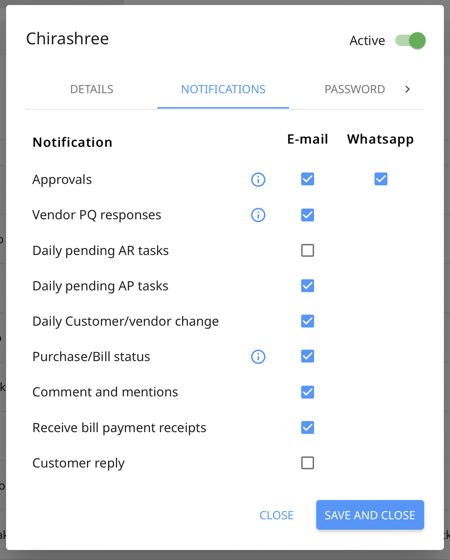
When a bill/PQ/PO/transaction is pending on someone’s queue, they get 2 types of notification:
- Immediately when the bill/PR/PQ/PO/transaction enters their queue
.png?width=450&height=525&name=pasted%20image%200%20(3).png)
- Start of the day as part of their daily briefing email
.png?width=450&height=545&name=pasted%20image%200%20(2).png)
Budgets
Put your budget management in easy mode! You can track the amount of money spent on any project/campaign or by a department in real-time.
To check the details of each budget, click on the budget name. You can see all the bills related to the budget along with the monthly budget reports.
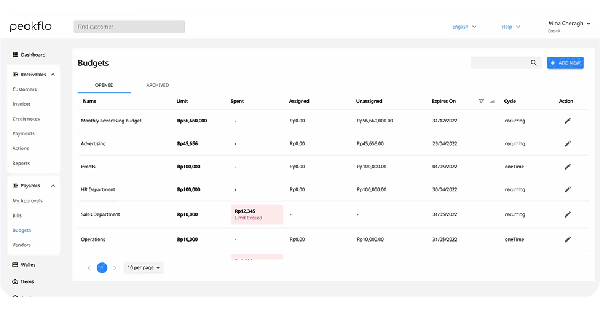
Bill maker/checker have access to view the budgets where they're the owners or members.
Learn more about Budget Management.
Vendor
Before raising any bills/PQ/POs, we need to learn about vendors.
Admins and bill makers/checkers have access to create and edit all vendor details such as addresses, bank details, and contacts. Vendor details have a 2-way sync between Peakflo and your accounting system. All vendors created in your accounting system will be present to your Peakflo account and vice versa. The synchronization happens every 5 mins.
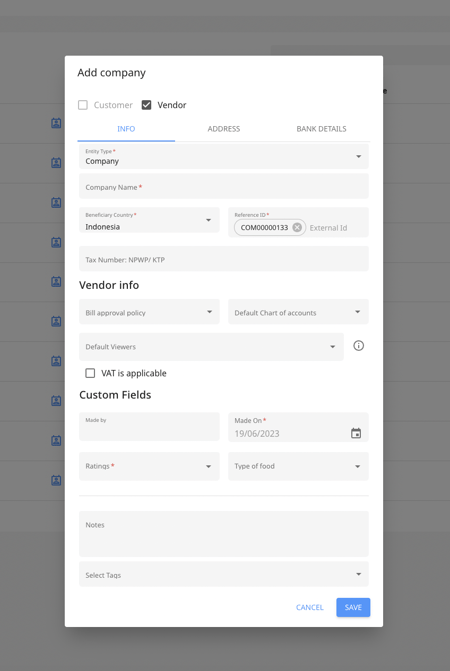
Here are some items to take into reminder when creating vendors:
- Custom tags can be created to categorize the vendors. The categorization depends entirely on your company. Popular categories to tag your vendors can be based on spending habits, the line of business, the size of the company, etc. Contact your Peakflo partner to set this up for your company!
Here's an example of tags: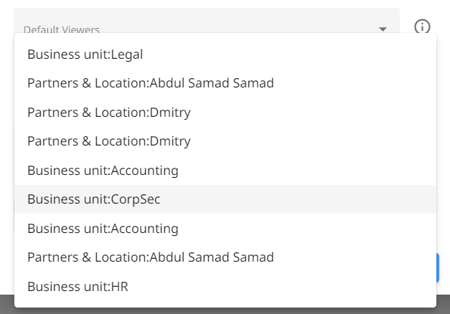
- When creating a bill/PQ for a vendor, the default chart of accounts (CoA) will automatically be populated on a line item level. Default CoA should be confirmed with the company’s accountant. Admins and accountants have access to modify the CoA before the bill is paid. If the Peakflo account is integrated with an accounting system, the list of COA is populated automatically from the accounting system.
-gif-gif.gif?width=600&height=353&name=WHATS-NEW-DEC-22_CHART-OF-ACCOUNTS_ALT2%20(2)-gif-gif.gif)
- When creating a bill/PQ for a vendor, the default approval policy (set on the vendor level) will automatically be populated. The default approval policy should be set by admins according to company policies for procurement and purchase. This can be modified by admins when the bills/POs are in a DRAFT state.
- Users added as default viewers will be able to view all bills/POs belonging to that vendor. You can also add multiple users.
- The vendor timeline highlights all actions carried out, including the status of the corresponding bills. To access a certain vendor timeline, click on any vendor name.
.png?width=600&height=267&name=pasted%20image%200%20(4).png)
Purchase Requests
Bill maker/checker has access to view and create PRs.
From the left sidebar, click on "Purchase Requests" under the "Payables" tab then click on "Add New" to create a new PR.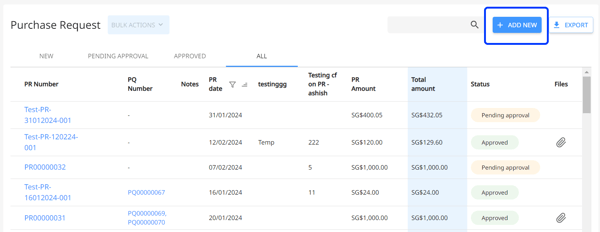
A new window will appear. Fill in all the details to create a PR.
Learn more about how to create PRs: How to create a purchase request and send it for approval?
After the PR is created, click on the newly created purchase request and click on the "Send for Approval" button to submit the PR for approval. 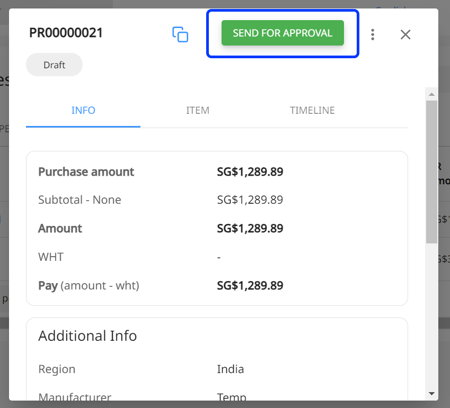
In the timeline you can see when the PR has been approved and when it matched with the PQ.

Purchase Order
Bill maker/checker has access to view and create POs. When the PQ is fully approved, the same document transforms into PO automatically.
By clicking on the "Create PO" button from the PQ tab you can generate a purchase order.

Additionally, POs can be mass uploaded to Peakflo. Check out this article for more details: How to mass upload purchase orders?
If your Peakflo account is integrated with an accounting system, we sync all your POs created in Peakflo into your accounting system. Learn more about how the data flow works on the Integrations page.
Once a PO gets full approval, it will show up in the Purchase Orders section, under the Approved-open column.

When the PO amount matches with 1 or multiple bills, the PO goes to the Approved-closed state AKA completely billed.
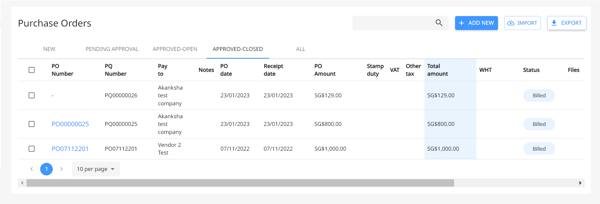
Peakflo also tracks any changes to PO and captures them in the timeline. Simply go to Purchase Orders and click on any PO you'd like to see. Bill maker/checker can view the entire history of the PO with the PO timeline.

Bills
Bill makers/checkers have access to all bills and modify all fields. They can override the defaults of the approval policy, budget, bill payment date, bill payment method while the Bill is in the Draft state.
You can also mass upload bills to Peakflo (in case you're not connected to accounting software).
To know more about mass upload or manual creation of bills (in case not connected to accounting software), please visit our help portal on how to create and upload bills.
Bills can also be automatically scanned using our OCR system. Vendors or Peakflo users can directly send the bill copy to our OCR mailbox. Peakflo automatically scans bill details with a high-level accuracy and saves them without any manual data entry. Sample mailbox details are mentioned below:
-gif.gif?width=600&height=284&name=users-can-access-the-email-to-send-bills%20(1)-gif.gif)
📘 Learn: How does OCR work?
If your Peakflo account is integrated with the accounting system, we will sync all the bills created in Peakflo to your accounting system. The synchronization happens in twice:
- When the bill is fully approved
- When a bill is paid and the corresponding transaction is fully approved
To create a bill from scratch, go to the "Bills" tab under the "Accounts Payable" section and click on "Add New".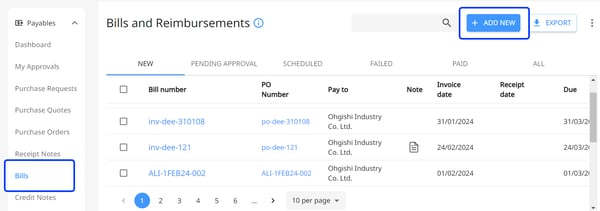
Add the information in the bill edit form and don't forget to match the bill with a PO by clicking on the "Match PO" button.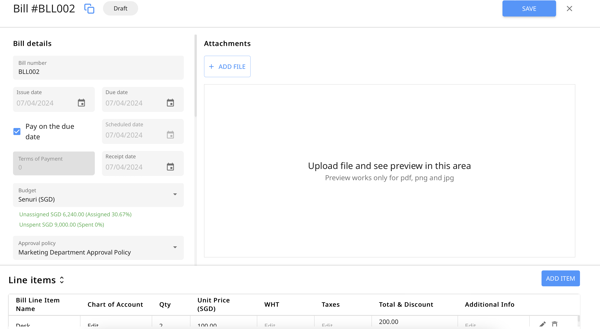
Bills can be matched to POs directly from the UI itself. This will automatically populate the PO line items and vendor details, avoiding any interim human error and skipping the time-consuming task of manual data entry.

📘 Read:
Bill makers/checkers can also add and edit bill line item details and tax details.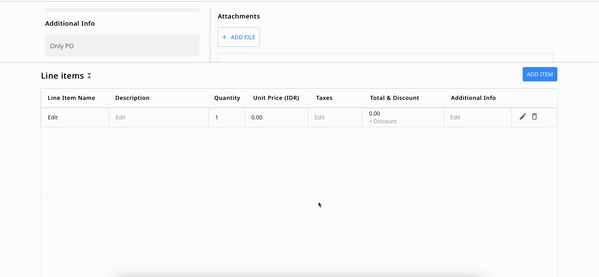
Recommended Reads:
Similar to the PO timeline, Peakflo also captures bill history in its timeline. Go to the Bills section and click on the bill you'd like to see the details.

We can even automate payments if you've enabled Peakflo wallet. Once the bill receives full approval, it goes to the scheduled state. On the bill's due date, payment will automatically be paid with the Peakflo wallet.
We keep the finance team and bill creator, updated with the details of the payment which can be found in the following email notifications:
- When a payment is successful:
.png?width=450&height=497&name=pasted%20image%200%20(8).png)
2. When a payment is failed:
.png?width=450&height=507&name=pasted%20image%200%20(9).png)
3. When the wallet is low on funds:
.png?width=450&height=499&name=pasted%20image%200%20(10).png)
So you don't have to worry about vendor payments, Peakflo's got your back! 💙
Bill makers/checkers can manually mark a bill as paid too. To manually mark a bill as paid, choose the bill you want to mark as paid. Click on the three dots on the top left of the bill and choose "Mark as paid".
Learn more here: How to manually mark bills as paid in Peakflo?
Custom Fields
Bill maker/checkers can see the custom fields mapped to bills/PRs/PQs,POs in the table view and edit in their edit forms.

Learn more about custom fields here: What are custom fields?
My Approvals
This is the section where all bills/PO/transactions pending with the approvers are shown. When approval items come to the user’s queue, they can receive notifications by Whatsapp or email. Users can approve, decline, or change the status to draft.

With these approvals, users can add comments and also mention other users to highlight changes or for audit purposes. Mentioning a user will enable view permissions of the bill/PO to that user.
.png?width=450&height=300&name=pasted%20image%200%20(16).png)
Important Note
When adding "@mentions" in the comments, if you want to send the notification to bill creator and bill viewer along with the mentioned user then check the box "Notify creators and Viewers".
- Bill creator is the user who created the bill.
- Bill viewers are:
- All bill approvers are added as bill viewers
- Default viewers from vendors are added as bill viewers
- Anyone mentioned in the bill is added as a bill viewers
- Rules can add bill viewers
- If the user is a budget admin, then the user is a bill viewer
If you don't want bill viewers and creators to get notified and only want the person whom you have mentioned to get the comment, you need to untick the box "Notify creators and Viewers" before clicking on "Write Comment".
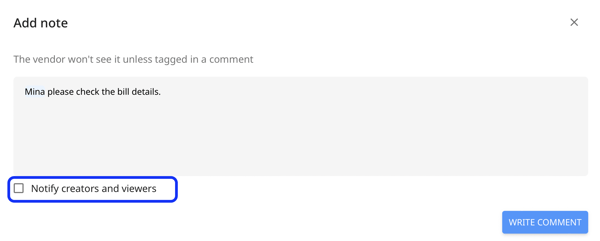
This page is mobile optimized so users can view attachments and approve bills/POs right from their fingertips.
-gif.gif?width=450&height=351&name=WHATS-NEW-DEC-22_access-all-approvals-from-the-tip-of-the-palm%20(1)-gif.gif)
The notification settings can be accessed from Settings. Click on Users and select your user name then go to the Notifications tab.
.png?width=450&height=537&name=pasted%20image%200%20(17).png)
Credit Notes
Bill makers/checkers have access to view credit notes tagged to bills.


Receipt Notes
Bill makers/checkers have access to view receipt notes tagged to bills.

Reports
Following are the reports in the Payables module:
- Change log report. This report highlights any changes done to the vendor/bill/PO details. It captures the fields changed along with the owner of the changes. Peakflo also shares an end-of-day email notifying users about the latest 5 changes made. This is to ensure that transparency is maintained along with the full audit log.
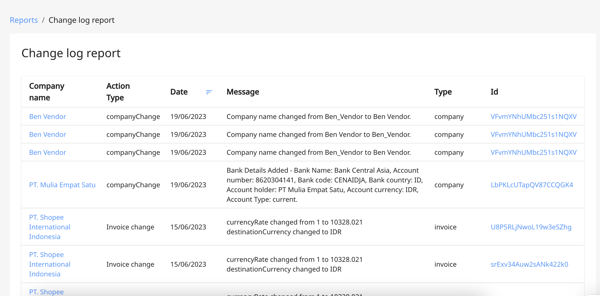
- Aging payables report: Admins have access to view and export the aging payables report. An accounts payable aging report is a critical accounting document that summarises the bills and invoices owed by a business, broken down by vendor and due date. Aging involves categorizing your company’s unpaid customer invoices and credit memos by date range. The report can be seen in a 15 days or 30 days period past the due date.
.png?width=600&height=286&name=pasted%20image%200%20(19).png)
If you have a presence in multiple countries, we will show a summary of pending payables per vendor and per currency.
.png?width=600&height=121&name=pasted%20image%200%20(20).png)
Dashboard
The dashboard shows the following 3 items:
- AP pending actions in the Peakflo account

- List of AP Wallets with currency and current balance. Admins have access to top-up these wallets.
.png?width=600&height=203&name=pasted%20image%200%20(21).png)
- Summary of spend in the selected period, which also shows the trend of payables in the past.
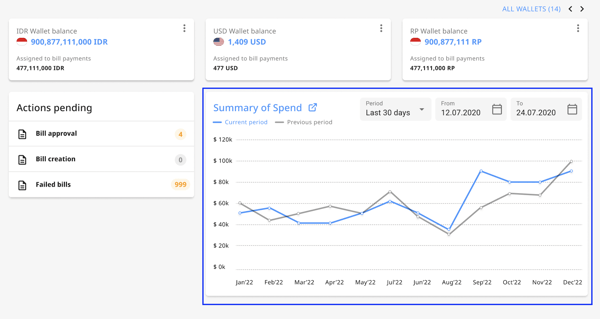
Accounting
This page contains all details associated with transactions and the ledger. All wallet transactions are detailed here: deposit, payout, top-up, payment, and transfer.
Transactions also go through the approval policies tagged to them. Admins can also export transaction and ledger tables. Transactions can be synced to your accounting system if there is an integration.
Transactions should typically be reviewed by the company's accountant before they are approved for synchronization. These transactions are akin to your bank transactions which will be reconciled in your accounting software with the corresponding account transactions, automatically by Peakflo.
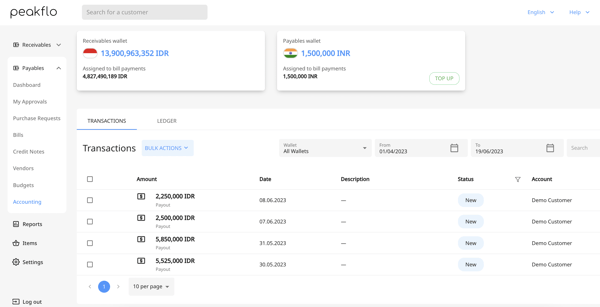

If you have queries about any module, feel free to contact your Peakflo partner or contact us at: support@peakflo.co